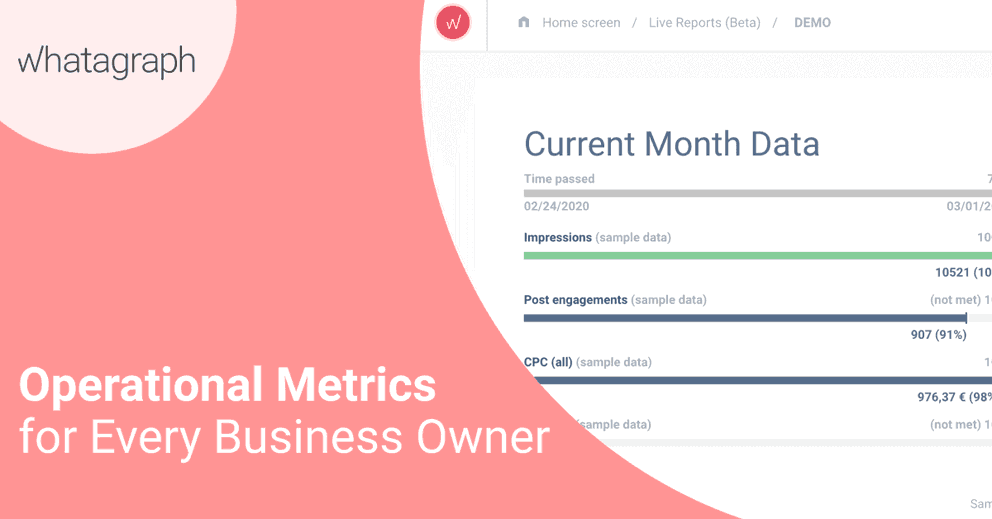The Key Operational Metrics for Every Business Owner
Following your gut feeling is not the way to measure your company’s performance. It takes a lot more than that to run a successful business. What you need is a thorough analysis of the sales, work, and financial results, and the only way to achieve that is to track relevant KPI metrics, including operational metrics.

Apr 07 2020●3 min read

What Are Operational Metrics?
Operational metrics are key performance indicators that allow you to see what’s going on in the business in real-time, or per hour, day, week, and month.
They provide a closer measurement and information about where people, processes, or systems are veering off course or falling behind, which allows you to take the necessary action immediately. KPI tracking will help you solve the problem before it becomes more serious and irreversible.
What Are Key Operational Metrics?
The key operational metrics depend on the type of your business.
However, they should be constituent of the following four parameters:
- The specific thing that needs to be measured
- The person who will measure it
- The time interval between measuring
- The frequency of the information being delivered to the management
Creating a business live report with these datasets can help you monitor the right values for your business.
Even though what operational metrics you’ll choose to track depend on your business and the target audience, some of the most important ones include the following.
Cost-Per-Click (CPC)
This operational metric is one of the most important for advertising. The CPC overview of campaigns explains the regular pricing model in online advertising. It allows you to compare different campaigns and determine which of them had the lowest price.
Cost-Per-Acquisition (CPA)
This metric is even more based on performance than the CPC metric. It doesn’t focus on the number of clicks but on the cost of acquiring a new customer. This is crucial for determining the success of campaigns and establishing future actions.
Absenteeism Rate
This operational metric comes from the Human Resources industry. It’s concentrated on the employees’ engagement which is essential for establishing an effective HR strategy. It includes the number of employees calling sick or skipping, suggesting the impact it will have in the future. You can help your HR department by implementing a core HR software that automatically keeps track of everything thanks to HR automation.
Overtime Hours
This operational metric can affect the Absenteeism Rate if the employees are dealing with lots of pressure.
Overtime hours should be tracked closely as they can be interpreted in many different ways, depending on the context. For instance, it can tell if the high volume of orders is leading to overtime hours.
Lead-to-Opportunity Ratio
This metric is related to the sales industry. It reveals details about the number of leads a sales manager or professional needs to reach revenue goals. This is the first part of the sales funnel, so it’s easy to notice which leads have become qualified ones and determine the ratio.
If you want to point the sales and marketing team in the right direction, you should investigate further into the exact source of the qualified leads.
Lead Conversion Ratio
This metric reveals how many interested people have turned into paying customers. Once you find your baseline, you’ll know the number of leads necessary for a good sales pipeline. A low conversion rate indicates that you need to make further changes and adjustments to the sales pipeline.
The Difference Between Strategic KPIs and Operational Metrics
Strategic KPIs are about tracking trends and progress toward a specific destination, or monitoring where your organization is now in comparison to where you want to be in the future.
On the other hand, operational metrics or KPIs give you information about where your business or organization is on a daily, hourly, weekly, or monthly basis. It provides closer insights which can help you take the necessary measure to prevent an issue from becoming a full-blown problem. You can also pay closer attention to eCommerce KPIs.
How to Evaluate Operational Performance?
The five important factors for evaluating operational performance are:
- Using a good, flexible template so that you can compare future operations;
- Identifying the top few metrics for the operation and using them as a guide in the beginning;
- Developing internal evaluation experts;
- Using a credible rating system to measure an organization’s improvement;
- Prioritizing opportunities.
Takeaway
Operational metrics create a dashboard of the organization’s vital signs, allowing you to make decisions for more efficient and leaner operations.
They help you to review data quality and performance more clearly, thus helping you to identify issues in different areas and find out the root causes.

WRITTEN BY
Gintaras BaltusevičiusGintaras is an experienced marketing professional who is always eager to explore the most up-to-date issues in data marketing. Having worked as an SEO manager at several companies, he's a valuable addition to the Whatagraph writers' pool.